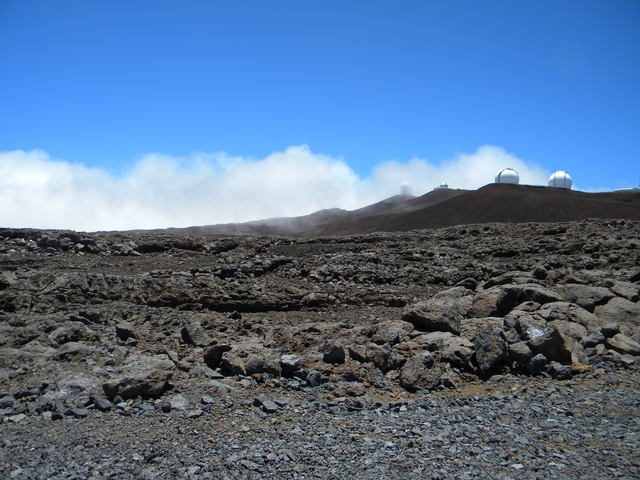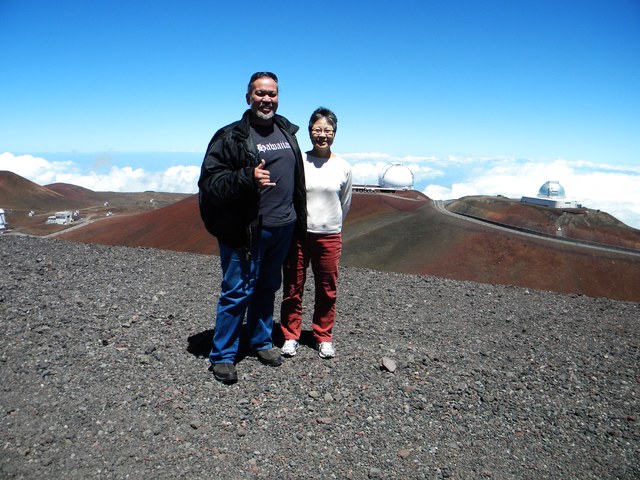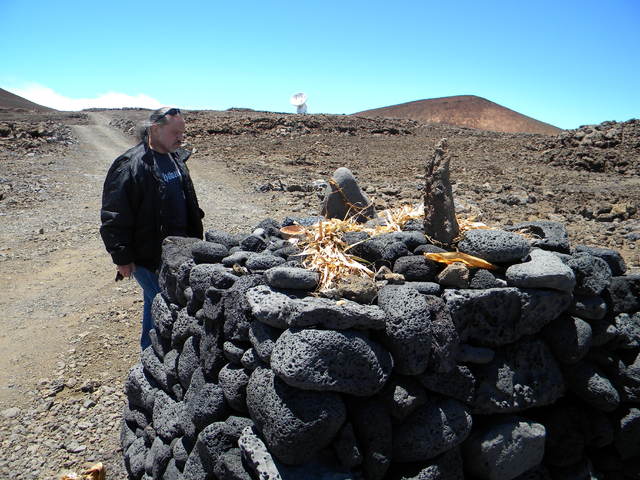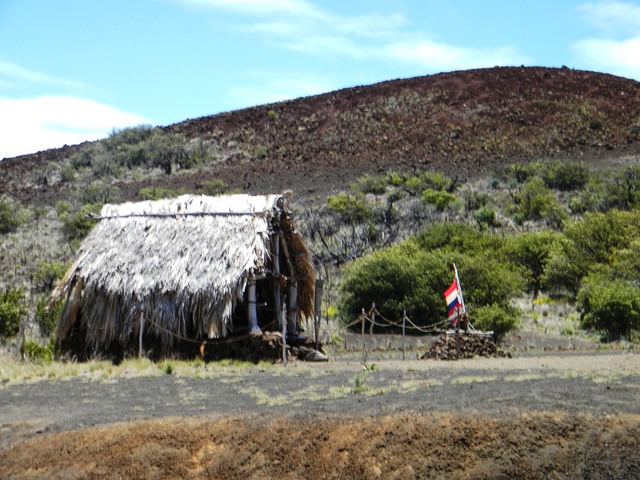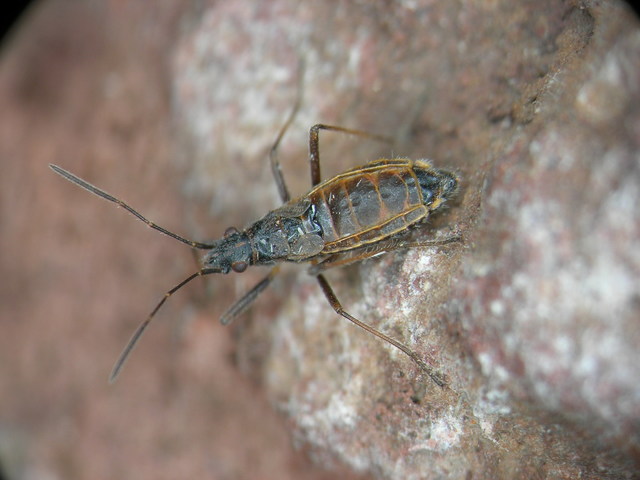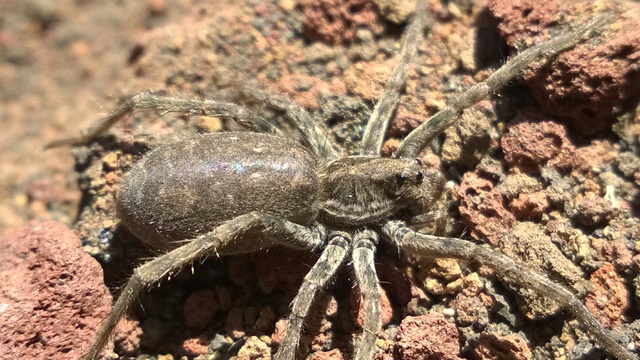Mountain stands tall as battle over telescope wages below
MAUNA KEA — Cinder crunches underfoot, the only real sound aside from a soft whisper of breeze on this warm August day atop the Mauna Kea summit.
The otherworldly quiet at 13,796 feet belies a continuing controversy below, as a multinational group seeks permission to build a $1.4 billion telescope just shy of the summit.
Opponents of the Thirty Meter Telescope, as it is called, saw their concerns validated in December when the Hawaii Supreme Court voided the project’s conservation district use permit, saying the state Board of Land and Natural Resources violated the state constitution when it approved the project in 2011.
A new contested case hearing is now underway, and preliminary motions were taken up Friday in a hearing in Hilo. The hearing officer, retired Hilo Circuit Court Judge Riki May Amano, plans a site visit next month.
Environmental and cultural concerns top the list of arguments raised by opponents. Some say the fragile ecosystem on the mountain is threatened by construction and operation of the massive telescope.
Some Native Hawaiians raise cultural concerns, calling the mountain sacred to themselves and their ancestors. Other Native Hawaiians disagree that the mountain is any more sacred than other areas on the island.
Recent polls seem to indicate the majority of residents favor the new project. Proponents cheer the advent of more scientific study and high-tech, high-paying jobs for the island, which was hit hard by the demise of the sugar industry. Others point to the ancient Hawaiian voyagers who relied on the stars as an example of the way forward for the native people.
Mauna Kea is a prime area for telescopes — there are currently 13 on the summit — because of unique atmospheric conditions. The summit is above the cloud layer, there is minimal light pollution, the air is dry and dust-free and the location allows observation of both the northern and southern skies together.
That’s not enough for Kealoha Pisciotta, a longtime opponent of the project and a litigant in the contested case hearing.
“I have always supported astronomy … however, I do not believe it is of so much importance that it should be allowed to overtake and destroy everything else in its wake,” Pisciotta explains in a blog posting on the Kahea website. “I am for protecting the cultural and natural resources of Mauna Kea, which unlike astronomy facilities, are actually threatened. Large scale astronomy is being conducted at over 93 sites around the world, but here on Mauna Kea many of the plant and animal species can only be found on Mauna Kea.”
Don’t let the starkly surreal piles of hard gray basalt, the heaps of brittle red cinder, the multicolored layers of wind-scrubbed pebbles fool you. This alpine stone desert may not be exactly teeming with life, but there are lots of critters here.
They may not be easily seen on the surface — the harsh dry air, intense solar radiation, temperatures that drop below freezing every night year round and scant 7 inches of precipitation in rain or snow annually tend to make it a forbidding place, sending the insects and spiders scurrying to the protection of the rocks.
But they’re there. And some are found nowhere else on Earth.
For the scientists, it’s not as much “gotta catch them all,” as “gotta study them all.” They may not resemble Pokemon monsters, but it’s an unusual organism that can survive the rarefied environment atop what is, counting the underwater part, the tallest mountain on Earth.
The wekiu bug (Nysius wekiuicola), for example, exists only in cinder cones above 11,500 feet on Mauna Kea. Scientists first studying the critter said construction of telescopes posed the single largest threat to its existence. After intensive study and approval of a management plan, the bug was taken off the list of endangered or potentially endangered species in 2011.
The flightless insect, about the size of a grain of rice, is different from its seed-eating cousins in that it has adapted by becoming a predator/scavenger that eats dead and disabled insects that are blown up the mountain and deposited at the peak. Its body is thought to contain a natural antifreeze, and it further regulates its temperature by moving up and down within the cinder cone.
Then there’s the agrotis moth. The larva of this moth genus is often referred to as a “cutworm,” and its damage to green plants is well-known to farmers. But in an environment without green plants, what does Mauna Kea’s endemic moth eat?
And, if it has turned predator like the wekiu bug, how can it catch up with prey, moving at, well, a caterpillar’s pace? Does it hide by day and feast at night like its flatland cousins, despite the freezing temperatures? Turns out, it doesn’t.
A seed-eater eating bugs? A night-flying moth flying by day?
“The mountain turns them all upside-down,” said Stephanie Nagata, director of the Office of Mauna Kea Management.
The mountain is a rich environment for research of all types, and scientists learn more every day.
Spiders, lichens, mosses and grasses round out the lifeforms known to inhabit the high reaches of the mountain that are being studied by scientists. There’s a dozen endemic arthropods scientists know about.
“Nobody ever thinks about these conditions in tropical regions. Nobody would ever associated blizzards or snow with Hawaii,” Nagata said. “The mountain is dynamic. It’s constantly moving.”
The Office of Mauna Kea Management is the primary agency responsible for managing the Mauna Kea Science Reserve, and was created as a result of a master plan adopted by the University of Hawaii Board of Regents in 2000.
The office is responsible for managing the 11,288-acre Mauna Kea Science Reserve, and is under the University of Hawaii at Hilo. That area includes the 525-acre astronomy precinct, where 13 telescopes are located.
Nagata said the site for the newest telescope was chosen specifically because it showed no endemic flora or fauna on-site. It also is a kind of basin just below the summit, where it’s not expected to have as much visual impact as telescopes currently on the summit.
Keeping the critters out that don’t belong on the mountain is as important as protecting the ones that do belong.
The management agency currently relies on public education and monitoring. If invasive species are shown to be a problem, the next step would be vehicle checkpoint inspections and, if needed, washing stations, Nagata said. That would be a challenge. First, because all water has to be trucked up the mountain, and second, because the used water would have to drain somewhere.
Ants have become the biggest threat, said Fritz Klasner, natural resource program manager for the Office of Mauna Kea Management. Hawaii has no native ants.
Predatory ants are of greatest concern because they’ve already been spotted just down-slope at Mauna Kea County Park and Puuhuluhulu. Argentine ants have already reduced silverswords (Argyroxiphium sandwicense) on Maui’s Haleakala, and environmental managers fear the same thing could happen to Mauna Kea’s endangered silverswords.
Currently, there are no ants above 9,300 feet on Mauna Kea.
Ants are primarily spread by humans, on plant materials they carry and in their vehicles and supplies. Vehicles carrying supplies to the telescopes at the summit are regularly inspected.
Ants caused a brief scare early last year when some black house ants were discovered on palm fronds brought up to thatch a hale put up by TMT protesters across from the visitor center at 9,400 feet. The ants were stopped before they could spread.
Rare and specially adapted flora and fauna aren’t the only things being protected on the mountain. Nagata’s staff of nine full-time and two part-time rangers are also charged with monitoring the mountain’s more than 260 archaeological and cultural sites, containing some 1,000 features.
Ancient Hawaiians built primitive shelters in the rocks, they mined basalt for tools and they buried family members on the mountain. The office employs a cultural resource program manager, and a senior advisor/cultural officer to oversee sensitive areas.
Cultural Officer Wallace Ishibashi recalls his family history of driving cattle over the mountain, and, later, pickup truck rides to the summit with a crowd of kids in the back. As a Native Hawaiian, Ishibashi agrees it’s important to preserve the culture and protect the archaeological sites.
Still, he says, there have always been laws governing where his people could and could not go, and when they were allowed to go there.
Ishibashi looks askance at some of the more zealous opponents last year seeding the roadway with rocks and otherwise blocking access. He notes that it is indeed a cultural practice of Hawaiians to place plants and other offerings on ahu, or rocks stacked as an altar. The material, however, is generally taken away after it is “consumed” by the deity, within 10 days, he said.
Stopping Thursday at an ahu blocking the access road to the proposed TMT site, Ishibashi checks out the dried plant materials on top. Some pieces have blown off onto the surrounding lava field.
Ishibashi shakes his head and walks away.
“We just let it go; let the courts decide,” Ishibashi says. “No sense making trouble.”


